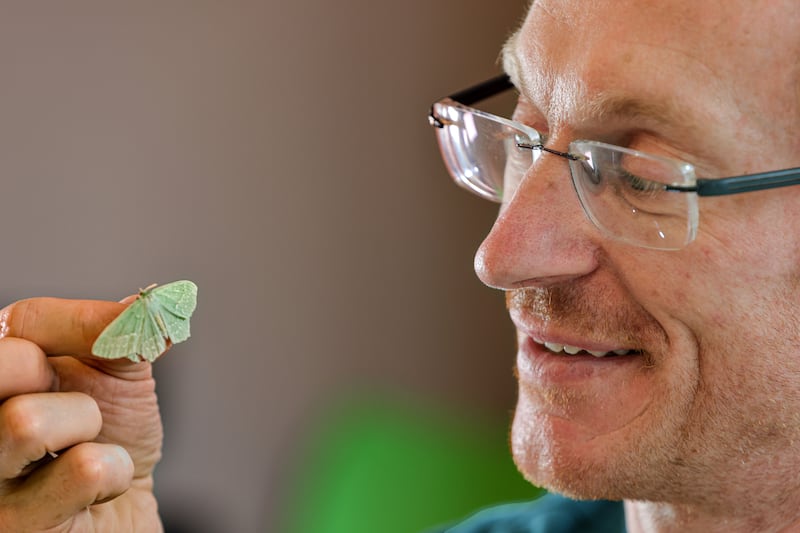Moths have no teeth and they certainly do not have jaws but that has not deterred an orthodontist in Co Kerry who has made some of the rarest recordings to date of the much-overlooked creatures in Killarney National Park.
Stephen Cotter’s hobby as a moth catcher came to light after he took part last year in a National Parks and Wildlife Service scheme (NPWS) surveying insect life. Almost 2,500 moths – many unique or uncommon – were recorded over 15 nights of trapping.
The most unexpected and interesting moth recorded was the Black Arches (Lymantria monacha), which had he says never previously been found in Munster.
His most recent confirmed finding, featured on the Moths Ireland website, is of Epinotia cinereana. It was noted last summer in a stand of aspens deep in Killarney National Park. The female was the first confirmed recording of the species in the country.
The best crime fiction of 2024: Robert Harris, Jane Casey, Joe Thomas, Kellye Garrett, Stuart Neville and many more
We’re heading for the second biggest fiscal disaster in the history of the State
Housing in Ireland is among the most expensive and most affordable in the EU. How does that happen?
Ceann comhairle election key task as 34th Dáil convenes for first time
Cotter has also found the rare and enchanting White Prominent Leucodonta in the oakwoods of Derrycunnihy, where it was never previously seen. The Killarney oakwoods are rich in moths, Cotter adds, and the national park has “a huge number” of species.
Overlooked scrubland, too, has a wealth of the creatures and a colony of the scarce Beautiful Brocade (many moths are called after textiles) on gorse was found by Cotter – only to be wiped out in recent gorse fires.

Originally from Cork but living and working in Killarney for years, Cotter was always interested in wildlife, but his curiosity grew during the pandemic, when he set about building moth traps with his children.
“I was amazed at what I found,” he says. “I had a primary schoolteacher, Mr Sheehan, who was hugely interested in wildlife and this definitely rubbed off on me.”
Participation in the National Parks and Wildlife Service’s wildlife survey helped to refine his interest. As part of the research, the moths are caught, recorded, photographed and then released. This data helps to chart populations and highlight species for conservation
“You can have a very different moth flora in Muckross than on the coast of Kerry,” says Cotter, who recorded the Valerian pug moth for the first time in Kerry, on a stand of Valerian plants at Inch Beach.
There are between 600 and 800 moth species in Kerry, he believes, but much of the county has never been surveyed.
“They are important pollinators,” Cotter says. “They are also eaten by just about everything else and without them our biodiversity would collapse.”
Moth caterpillars eat a diverse range of things including rotting leaves and wood, and even deer horns.
Many moths live only a few weeks. For example, the Goat moth – measuring 1.5 inches – spends up to four years as a caterpillar in the middle of the willow tree. It then just lives for a few weeks as an adult.
There is method to finding the moths and Cotter pinpoints the plants moth caterpillars feed upon, before heading out with traps, nets and lights. It is mainly nocturnal work, as the light attracts the moths to the traps, but they must be released before dawn or robins will take them as an easy breakfast.
Moth trapping begins in late April and goes on for about three months – peaking in June and July. Ideally, it takes place when the weather is dry and the moon is not too bright.
Cotter is often accompanied by his 11-year-old son, Ultan. “To see the amazement in a kid’s face when looking at some of our spectacular moths is a treasure,” he says.

“Surrounded by the churring of grasshopper warblers and the cuckoos, a million midges. It’s a magical and an intense experience. Alas, most moths are declining.”
Night time light are a bogey, distracting moth flight paths, disorienting them and stopping them from breeding.
As May approaches, Cotter is encouraging his neighbours not to cut the grass and leave some verges uncut.
“And, please, cut down on outside lights,” he pleads. “Switching off lights on outbuildings late at night, correcting poorly focused security lights, even closing the curtains all help to reduce light pollution.”



